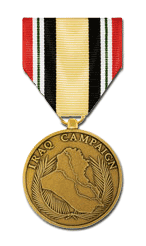
Establishing Legislation
The Iraq Campaign Medal was established by Public Law 108-234, signed into law by President George W. Bush on May 28, 2004 and implemented by Executive Order 13363, signed by President Bush on November 29, 2004.
Effective Dates
The Iraq Campaign Medal may be awarded to members of the Uniformed Services of the United States who serve, or who have served in Iraq or its contiguous waters and air space, in support of Operation Iraqi Freedom from March 19, 2003 to a date to be announced (or until the cessation of Operation Iraqi Freedom).
Criteria
The area of eligibility encompasses all land area of the country of Iraq and the contiguous water area out to 12 nautical miles, and all air spaces above the land area of Iraq and above the contiguous water area out to 12 nautical miles.
To be eligible for the Iraq Campaign Medal, a Service member must be assigned or attahced to a unit participating in Operation Iraqi Freedom in Iraq for 30 consecutive days or for 60 nonconsecutive days or meet one of the following criteria:
- Be engaged in actual combat against the enemy under circumstances involving grave danger of death or serious bodily injury from enemy action, regardless of the amount of time the individual has served in Iraq;
- While participating in Operation Iraqi Freedom or on official duties (regardless of the time spent in Iraq) is killed, wounded or injured to the extent that he or she requires medical evacuation from Iraq; or,
- While participating as a regularly assigned aircrew member flying sorties into, out of, within, or over Iraq in direct support of Operation Iraqi Freedom; each day that one or more sorties are flown in accordance with these criteria shall count as one day towards the 30 consecutive or 60 nonconsecutive day requirement.
- Service members who qualified for the War on Terrorism Expeditionary Medal by reason of service between March 19, 2003 and April 30, 2005 shall remain qualified for that medal. However, any such person may be awarded the Iraq Campaign Medal in lieu of the War on Terrorism Expeditionary Medal for that service, at his or her request. In addition, any Army soldier who was authorized the arrowhead device may be awarded the Iraq Campaign Medal with arrowhead device in lieu of the War on Terrorism Expeditionary Medal with arrowhead device.
- No service member shall be entitled to both the War on Terrorism Expeditionary Medal and the Iraq Campaign Medal for the same act, achievement, or period of service.
- Only one award of the Iraq Campaign Medal may be authorized for any individual.
- The Iraq Campaign Medal may be awarded posthumously to any Service members who loses his or her life while, as a direct result of participating in qualifying operations, without regard to the length of time in the area of eligibility, if otherwise applicable.
Order of Precedence
The Iraq Campaign Medal is worn after the Afghanistan Campaign Medal and before the War on Terrorism Service Medal.
Devices
Originally, service stars are not authorized for the Iraq Campaign Medal; however, in February of 2008 the following service stars (with their respective dates) were announced:
- Liberation of Iraq (March 19, 2003 to May 1, 2003)
- Transition of Iraq (May 2, 2003 to June 28, 2004)
- Iraqi Governance (June 29, 2004 to December 15, 2005)
- National Resolution (December 16, 2005 to a date to be determined)
Designer
The basic design of the obverse of the Iraq Campaign Medal was executed by The Institute of Heraldry; the design of the reverse was suggested by the Awards and Decorations Branch of the US Marine Corps.
Descripton and Symbolism
Obverse
In the center of a bronze medallion, a relief of Iraq surmounted by two lines throughout, surmounting a palm wreath. Above is the inscription, IRAQ CAMPAIGN. The relief of Iraq indicates the geographic area of operations, and the two lines represent the Tigris and Euphrates rivers, recalling Iraq's title, "the land of two rivers." The palm wreath denotes durability and strength of the efforts to establish the mission of Iraqi Freedom.
Reverse
In the center of a bronze medallion, the statue of Freedom surmounting a sunburst, enclosed by a laurel wreath over the inscription, FOR SERVICE IN IRAQ.
Ribbon
The ribbon consists of a khaki stripe in the center, which represents the desert. The khaki is bordered by black, which represents the success of Islam in the region. The black stripe is bordered on either side by a white stripe (denoting generosity), which is bisected by a pinstripe of green (the traditional color of Islam). The ribbon has red edge stripes, which honors courage in fighting for freedom in Iraq. These are also the collective colors of the Iraqi Flag.